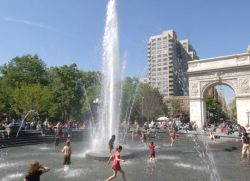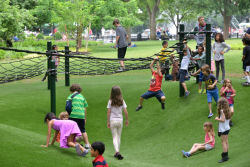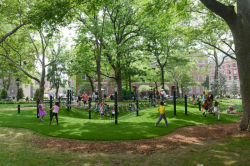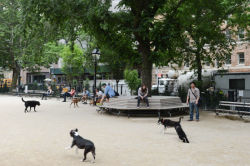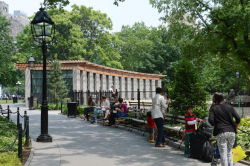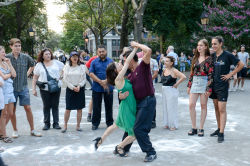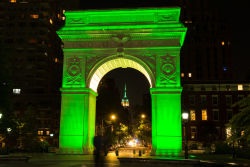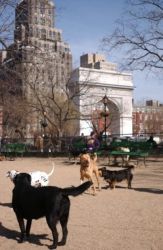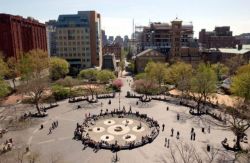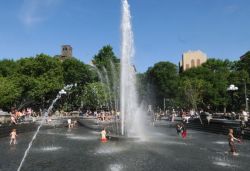Washington Square Park
The Daily Plant : Wednesday, January 24, 2007
The Free And Independent Republic Of Washington Square (Part II)
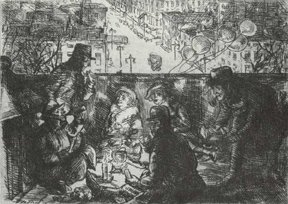
John Sloan (1871-1951) Arch Conspirators, 1917; Courtesy of New York University
Yesterday in The Daily Plant:
But perhaps as significant a break with the artistic past as the 1913 Armory Show was an event that occurred 90 years ago today in Washington Square Park.
And now, today’s conclusion:
It was on the cold, snowy evening of January 23, 1917 that painters John Sloan and Marcel Duchamp, poet Gertrude Drick, and Provincetown Playhouse actors Alan Russell Mann, Betty Turner, and Charles Ellis slipped through an unlocked door and climbed up the spiral staircase to the roof of the Washington Arch. These six so-called “Arch Conspirators” then spread out blankets, hung Chinese lanterns, tied red balloons to the arch’s parapet, sipped tea, shot off cap pistols, and conversed until dawn. At some point during the night, the ringleader, Gertrude Drick, read a proclamation by candlelight into the windy night -- a declaration of independence for what the Arch Conspirators, somewhat ironically, called the “Free and Independent Republic of Washington Square.”
That cold January night on the top of the Washington Arch was immortalized graphically by John Sloan’s 1917 print entitled “Arch Conspirators,” depicting the artists and bohemians chatting by candlelight high above Fifth Avenue, balloons buffeted by the wind. Social commentator Luc Sante astutely noted that the slightly comical declaration of January 23, 1917 “actually named the thing that all the inhabitants of the Greenwich Village bohemia of that time were aiming for, a revolution in more than just a legislative sense, a free territory untrammeled by convention.”
While 1917’s Declaration of Independence was soon forgotten, Greenwich Village’s spirit of rebellion and breaking with the past was very much alive, then and now. It is no understatement to declare that modern American art became deeply rooted in and around Washington Square in the decades after the Arch Conspirators’ stunt. Artists like Sloan and Glackens were the vanguard of an entire movement of realist painters, including Thomas Hart Benton and Edward Hopper, who painted around Washington Square. Other strains of art followed in Duchamp’s iconoclastic footsteps, most notably Jackson Pollock and other abstract expressionists. Gertrude Vanderbilt Whitney established the Whitney Museum of American Art in a studio a few blocks from the square, and sustained an entire generation of emerging artists by her encouragement and patronage.
In more recent years, Washington Square continued to exert creative gravity for new generations of artists, writers, and performers -- Bob Dylan, Joan Baez, Charlie Parker, and Allen Ginsberg all performed in and around the square. These days, the access door on the west pier of Washington Arch is locked, the spiral stairs secured, and the arch roof off limits. But on a chilly January night, 90 years after Sloan, Drick, Duchamp and the other Arch Conspirators proclaimed the independence of Washington Square, rebellion and artistic expression remain very much a part of the spirit of Greenwich Village.
Written by Erik Peter Axelson
QUOTATION FOR THE DAY
“The most remarkable thing about my mother is that for thirty years she served the family nothing but leftovers.
The original meal has never been found.”
Calvin Trillin
(1935 - )
Check out your park's Vital Signs
Clean & Safe
Green & Resilient
Empowered & Engaged Users
Share your feedback or learn more about how this park is part of a
Vital Park System

